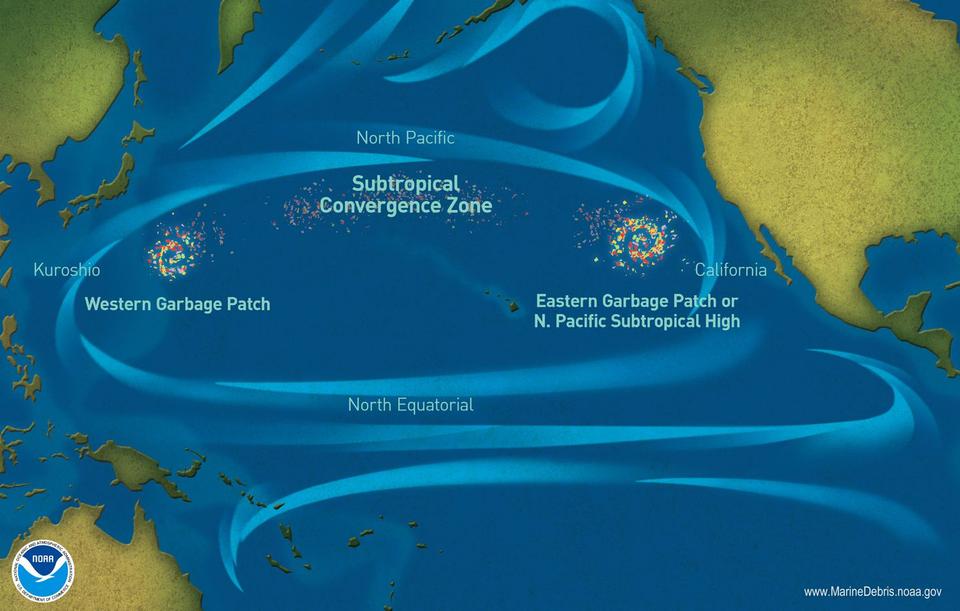Researchers find new life within the Great Pacific Garbage Patch, essentially plastic garbage, thriving in a coral-like yet inanimate environment.
A recent article published in Nature Communications alerts us to the existence of a ‘neopelagic community’ thriving in the Great Pacific Garbage Patch, showing that the plastic debris in the midst of the ocean, once thought inhabitable, can be host to organisms from coastal regions as well as open sea creatures.
What is the Great Pacific Garbage Patch?
The Great Pacific Garbage Patch is a mass of plastic detritus accumulating in the middle of the ocean. National Geographic calls it “a collection of marine debris in the North Pacific Ocean”, defining “Marine debris … [as] litter that ends up in the ocean, seas, and other large bodies of water”.
To be more specific, the Great Pacific Garbage Patch is the combination of “two distinct collections of debris”, the Eastern Garbage Patch and the Western Garbage Patch, bounded by the massive North Pacific Subtropical Gyre.
The Great Pacific Garbage Patch. Map by the National Oceanic and Atmospheric Administration (NOAA).

What is the ‘neopelagic’ community?
An article published in the Nature Communications journal’s December 2, 2021 issue, defines the ‘neopelagic’ community as a new mixture of open sea (pelagic) species, “evolved to live on floating marine substrates and marine animals, and coastal species, once assumed incapable of surviving long periods of time on the high seas”. Thanks to the “vast supply of durable and highly buoyant plastic pollution” the neopelagic community has found a suitable habitat for “both pelagic and coastal rafting species”.
How does plastic contribute to the ocean animals’ survival?
The researchers writing in Nature Communications say that the global increase in plastic pollution is an “unexpected” example of “biogeographic barriers historically imposed by oceans and continents are quickly becoming obsolete—socially, economically, and now ecologically”. According to the study, “plastic rafts create a more permanent opportunity for coastal species to transit to ocean basins and a long-term enduring habitat to colonize in the open ocean”.
These coastal plants and animals “hitching a ride on the ever-growing deluge of plastic debris and traveling hundreds of miles from shore” is creating a new kind of ecosystem in the Great Pacific Garbage Patch, “the largest accumulation of moving plastic debris in the ocean”.
Plastics - a love-hate story
The Great Pacific Garbage Patch is estimated to cover an estimated 610,000 square miles (more than 1.5 million square kilometres) of ocean with plastics left over from human consumption.
The Hill’s Joseph Guzman reports that some 79,000 metric tons of plastics, including fishing nets, plastic bottles and microplastics, form the Great Pacific Garbage Patch, “halfway between Hawaii and California”.
Plastics, made from fossil-fuel based chemicals such as natural gas or petroleum, do not decompose; rather, they break up into smaller and smaller pieces, ending up as microplastics but never quite disappearing.
“The issues of plastic go beyond just ingestion and entanglement," Linsey Haram, lead author of the article and former postdoctoral fellow at the Smithsonian Environmental Research Center (SERC), says in a press release. “It's creating opportunities for coastal species' biogeography to greatly expand beyond what we previously thought was possible.”
"The open ocean has not been habitable for coastal organisms until now," says SERC senior scientist Greg Ruiz, who heads the Marine Invasions Lab where Haram worked. "Partly because of habitat limitation –– there wasn't plastic there in the past –– and partly, we thought, because it was a food desert."
The press release explains that the authors don’t yet know how common these new communities are, whether they can sustain themselves or if they even exist outside the North Pacific Subtropical Gyre (the site for the Great Pacific Garbage Patch).
“Scientists estimate cumulative global plastic waste could reach over 25 billion metric tons by 2050,” the press release notes. “With fiercer and more frequent storms on the horizon thanks to climate change, the authors expect even more of that plastic will get pushed out to sea. Colonies of coastal rafters on the high seas will likely only grow. This long-overlooked side effect of plastic pollution, the authors said, could soon transform life on land and in the sea.”
THUMBNAIL IMAGE: Neopelagic communities are composed of pelagic species, which evolved to live on floating marine substrates and marine animals, and coastal species, once assumed incapable of surviving long periods of time on the high seas. (Nature Communications/ illustrated by © 2021 Alex Boersma)
HEADLINE IMAGE: The Great Pacific garbage patch causes vast quantities of trash to wash ashore at the south end of Hawaii. (Wikimedia Commons/Picture by & © Andy Mabbett, CC by-sa 3.0)
Social media is bold.
Social media is young.
Social media raises questions.
Social media is not satisfied with an answer.
Social media looks at the big picture.
Social media is interested in every detail.
social media is curious.
Social media is free.
Social media is irreplaceable.
But never irrelevant.
Social media is you.
(With input from news agency language)
If you like this story, share it with a friend!
We are a non-profit organization. Help us financially to keep our journalism free from government and corporate pressure














0 Comments